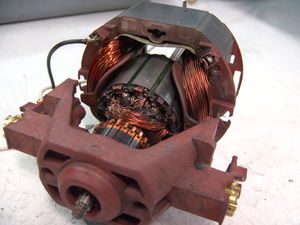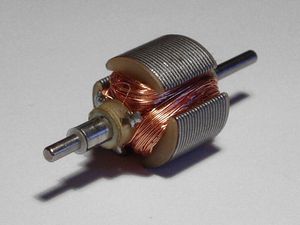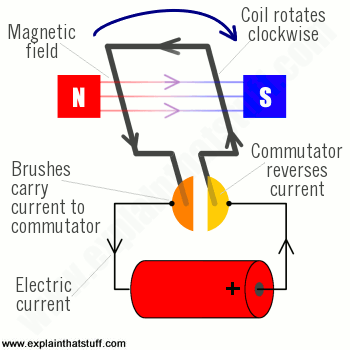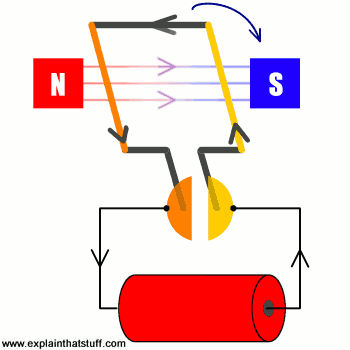Electric motor: Difference between revisions
J.williams (talk | contribs) m (1 revision imported) |
No edit summary |
||
| Line 1: | Line 1: | ||
[[category:371 topics]] | [[category:371 topics]] | ||
[[category:301 topics]] | [[category:301 topics]] | ||
[[Category:Done | [[Category:Done 2018-05-18]] | ||
[[File:Universalmotor_3.JPG|300px|thumb|Figure 1. An electric motor from an old vacuum cleaner.<ref>Wikimedia Commons [Online], Available: http://upload.wikimedia.org/wikipedia/commons/c/cc/Universalmotor_3.JPG</ref>]] | [[File:Universalmotor_3.JPG|300px|thumb|Figure 1. An electric motor from an old vacuum cleaner.<ref>Wikimedia Commons [Online], Available: http://upload.wikimedia.org/wikipedia/commons/c/cc/Universalmotor_3.JPG</ref>]] | ||
[[File:Electric_Motor_Rotor.jpg|300px|thumb|Figure 2. An electric rotor.<ref>Wikimedia Commons [Online], Available: http://upload.wikimedia.org/wikipedia/commons/8/80/Electric_Motor_Rotor.jpg</ref>]] | [[File:Electric_Motor_Rotor.jpg|300px|thumb|Figure 2. An electric rotor.<ref>Wikimedia Commons [Online], Available: http://upload.wikimedia.org/wikipedia/commons/8/80/Electric_Motor_Rotor.jpg</ref>]] | ||
<onlyinclude>An '''electric motor''' is a device used to convert [[electricity]] into [[work|mechanical energy]] | <onlyinclude>An '''electric motor''' is a device used to convert [[electricity]] into [[work|mechanical energy]]—opposite to an [[electric generator]].</onlyinclude> They operate using principles of [[electromagnetic force|electromagnetism]], which shows that a [[force]] is applied when an [[electric current]] is present in a [[magnetic field]]. This force creates a [[torque]] on a loop of wire present in the magnetic field, which causes the motor to spin and perform useful work. Motors are used in a wide range of applications, such as fans, power tools, [[appliance]]s, [[electric vehicle]]s, and [[hybrid car]]s. | ||
==How they work== | ==How they work== | ||
| Line 12: | Line 12: | ||
The main parts of a DC motor include:<ref name=yea>Explain that stuff, ''Electric motors'' [Online], Available: http://www.explainthatstuff.com/electricmotors.html</ref> | The main parts of a DC motor include:<ref name=yea>Explain that stuff, ''Electric motors'' [Online], Available: http://www.explainthatstuff.com/electricmotors.html</ref> | ||
* '''Stator''' | * '''Stator:''' The stationary part of the motor, specifically the [[magnet]]. [[Magnet#Types of Magnets|Electromagnets]] are often used in order to provide more power. | ||
* '''Rotor''' | * '''Rotor:''' The coil that is mounted on an axle and spins at high speeds, providing rotational mechanical energy to the system. | ||
* '''Commutator''' | * '''Commutator:''' This component is key in DC motors, and can be seen in Figure 3 and 4. Without it, the rotor would not be able to spin continuously due to opposing forces created by the changing current. The commutator allows the rotor to spin by reversing the current each time the coil does a half turn. | ||
* '''Power source''' | * '''Power source:''' Supplies an [[electromotive force]] which causes current to flow in the system. | ||
* '''Brushes''' | * '''Brushes:''' These are connected to the terminals of the power source, allowing [[electric power]] to flow into the commutator. | ||
<gallery caption="DC Motor" widths="350px" heights="350px" > | <gallery caption="DC Motor" widths="350px" heights="350px" > | ||
Revision as of 20:15, 11 May 2018


An electric motor is a device used to convert electricity into mechanical energy—opposite to an electric generator. They operate using principles of electromagnetism, which shows that a force is applied when an electric current is present in a magnetic field. This force creates a torque on a loop of wire present in the magnetic field, which causes the motor to spin and perform useful work. Motors are used in a wide range of applications, such as fans, power tools, appliances, electric vehicles, and hybrid cars.
How they work
Motors have many different working parts in order for them to continually rotate, providing power as needed. Motors can run off of direct current (DC) or alternating current (AC), and both have their benefits and drawbacks. For the purpose of this article a DC motor will be analyzed, to read about AC motors, click here.
The main parts of a DC motor include:[3]
- Stator: The stationary part of the motor, specifically the magnet. Electromagnets are often used in order to provide more power.
- Rotor: The coil that is mounted on an axle and spins at high speeds, providing rotational mechanical energy to the system.
- Commutator: This component is key in DC motors, and can be seen in Figure 3 and 4. Without it, the rotor would not be able to spin continuously due to opposing forces created by the changing current. The commutator allows the rotor to spin by reversing the current each time the coil does a half turn.
- Power source: Supplies an electromotive force which causes current to flow in the system.
- Brushes: These are connected to the terminals of the power source, allowing electric power to flow into the commutator.
- DC Motor
Figure 3: A basic setup of a DC motor.[3]
Figure 4: An animation of the motor in action. The commutator rotates in order for the rotor to spin continuously.[3]
References
- ↑ Wikimedia Commons [Online], Available: http://upload.wikimedia.org/wikipedia/commons/c/cc/Universalmotor_3.JPG
- ↑ Wikimedia Commons [Online], Available: http://upload.wikimedia.org/wikipedia/commons/8/80/Electric_Motor_Rotor.jpg
- ↑ 3.0 3.1 3.2 Explain that stuff, Electric motors [Online], Available: http://www.explainthatstuff.com/electricmotors.html



